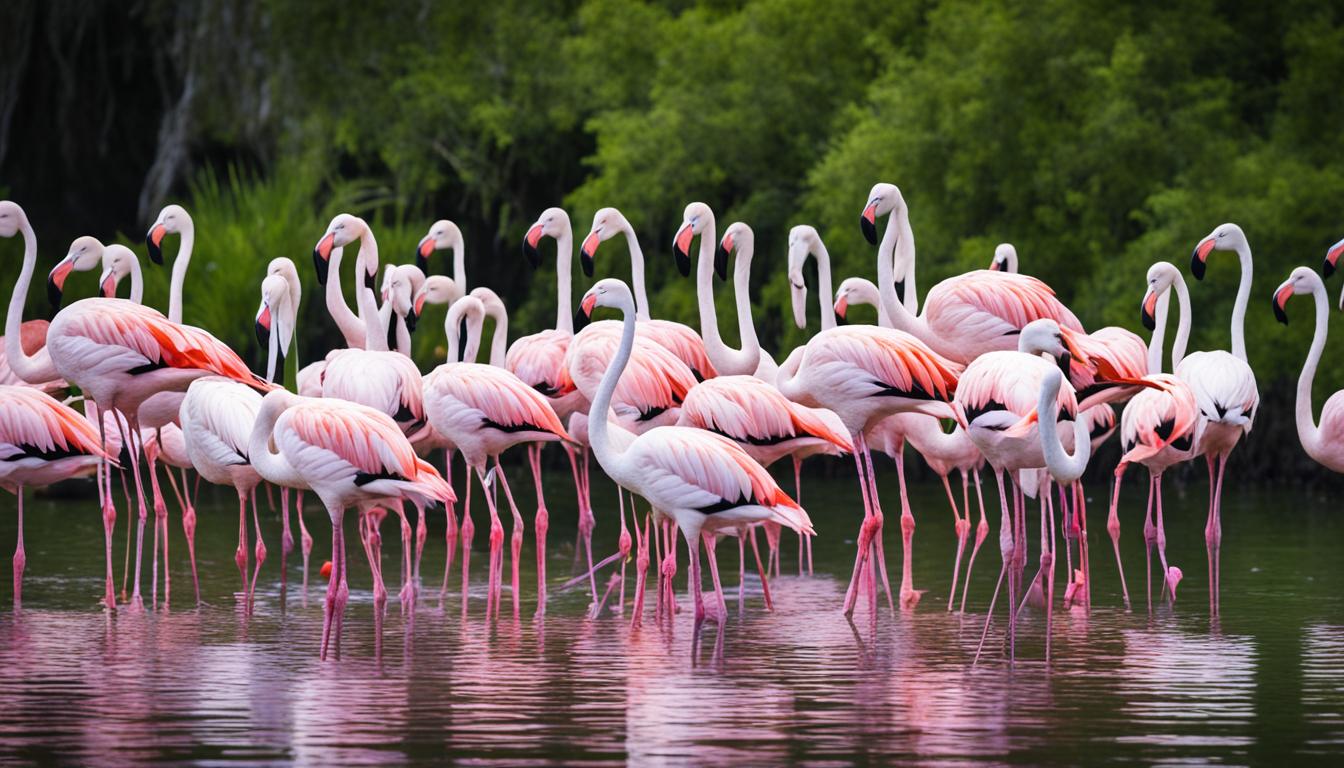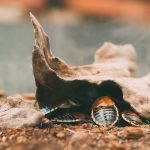The American flamingo stands out with its bright pink to red feathers and a black-tipped bill. It has been spotted in parts of the USA. Early naturalists, such as John James Audubon, wrote a lot about wild flamingos in the USA. Unfortunately, these beautiful birds started declining because of the plume trade. This led to fewer of them in the wild.
Nowadays, American flamingos can still be found, especially in Florida. This suggests that some are wild and not just pets that got away.
Introduction to Wild Flamingos in the USA
Wild flamingos are known by many, especially the American flamingo. They are a key part of the coasts in the United States. From old days to now, flamingos stand out in the native fauna of the USA. They are loved for their look and interesting actions.
In Florida and along the Gulf Coast, bird lovers gather for coastal birdwatching in the United States. These areas are perfect for flamingos. Though they’ve faced tough times, there’s hope they will thrive again.
Exploring for flamingos is not just about watching them. It’s also a dive into the diverse life on the coast. As part of the native fauna of the USA, these birds show endurance and ability to adjust.
Let’s compare American flamingos with other coastal birds. This will make them easier to spot and more appreciated when birdwatching:
| Bird Species | Plumage Color | Habitat | Behavior |
|---|---|---|---|
| American Flamingo | Pink to Red | Coastal Lagoons, Mudflats | Social, Ground Feeder |
| Great Blue Heron | Blue-Gray | Wetlands, Marshes | Solitary, Stalker/Predator |
| Brown Pelican | Brownish-Gray | Coastal Shorelines | Social, Diving Feeder |
Historical Presence of Flamingos in Florida
Looking into the historical wild bird species in the USA reveals a big part of Florida’s past. Early naturalists carefully noted the presence of American flamingos in the state. They made it clear that these birds were everywhere.
Exploration by Early Naturalists
Early naturalists offered us a rare chance to learn about American flamingos. John James Audubon, for example, talked about the many flamingos in Florida. His work is still very important today, telling us how common they were back then.
Impact of the Plume Trade
The story of historical wild bird species in the USA got sad because of the plume trade. In the 19th century, people wanted bird feathers for fashion. This hurt many bird kinds, including the American flamingo, which started disappearing quickly.
Are there wild flamingos in the USA?
Are there wild flamingos in the USA? This has sparked many debates among bird experts and wildlife enthusiasts. It’s vital to determine if they’re truly wild or if they came from captivity. This knowledge is key for their proper conservation.
Finding out if American flamingos are truly wild is tough. Differentiating them from escapees is vital. It helps in collecting right data and in planning how to protect them. Knowing if there are wild flamingos changes how their conservation is managed and funded.
For bird experts, studying the behavior and movements of these flamingos is crucial. Learning their migration and breeding details gives important clues. It helps in telling wild birds apart from those that escaped. This makes sure the right focus goes on saving them.
Experts frequently debate whether USA has wild flamingos. Some confirm it while others doubt it. Answering this question precisely continues to interest those in bird conservation.
Modern Sightings and Populations
American flamingos are being seen more in Florida and other states, showing they might not just be escapees from zoos. Birdwatchers and researchers have noticed more of these colorful birds in the wild. This suggests there might be real wild flamingo populations in the U.S.
These sightings include flamingos from places like the Bahamas and Cuba. They have been seen in the U.S., showing interesting migration patterns. Important places for sightings are the Florida Keys, Everglades National Park, and the Gulf Coast.
Knowing where these flamingos live and how they act is very important. It helps in their conservation, keeping their natural homes safe.
- Florida Keys: Known for hosting several documented instances of wild flamingos.
- Everglades National Park: A significant area where these birds can often be seen.
- Gulf Coast: Reports suggest potentials of small populations existing in this region.
People who watch birds and those who love nature play a big role in this. By keeping an eye out and protecting these beautiful birds, their future in the U.S. looks hopeful.
American Flamingo: Physical Appearance and Characteristics
The American flamingo is known for its bright, eye-catching look. It stands out with its long, thin neck and legs that give it a graceful appearance. Its feathers range from pink to red because of its food. You can recognize it by the black on its wings and bill, showing you it is a unique American bird.
Distinctive Features
This bird is different from most others. It has a long neck, long legs, and a pink to red body. Its black accents make it stand out even more. These features help it survive and move in its environment.
Diet and Feeding Habits
What the flamingo eats is key to its beautiful colors. It mostly feeds on algae and small shrimp. These foods are full of carotenoids, making the bird’s feathers turn pink or red. Flamingos use their special bills to sift out their food from the water. Knowing about their diet helps us understand their stunning appearance better.
Preferred Habitats of Flamingos in the United States
Flamingos are iconic in many parts of the world, including the USA. These big birds need specific places to live to meet their lifestyle and food needs. Several spots in the USA are important for them.
Habitats in Florida
Florida is a hotspot for flamingos. The Everglades, Biscayne Bay, and the Florida Keys offer what flamingos need. They find saline lagoons, mudflats, and shallow water vital for their life.
The Everglades stands out due to its vast expanses of wetland, making it ideal for flamingos to forage for food.
Everglades’ flamingos are a major draw for bird lovers and scientists. Many areas are protected, keeping things suitable for flamingos.
Potential Habitats in Other States
Florida is key, but other states are also promising. Places like Texas and California have been shaping up to welcome these birds. This might mean more places in the US could see flamingos.
| Location | Habitat Features | Flamingo Presence |
|---|---|---|
| Everglades | Saline lagoons, expansive wetlands | High |
| Biscayne Bay | Mudflats, shallow water zones | Moderate |
| Florida Keys | Coastal locations, protected areas | Moderate |
| Texas (Artificial Wetlands) | Man-made, shallow water bodies | Potential |
| California (Coastal Regions) | Shores, estuaries | Potential |
Behavior and Social Structure
Learning about American flamingo behavior lets us peek into their intriguing world. These creatures are very social. They gather in large groups, from small to thousands. This isn’t just about hanging out; it helps them survive by improving breeding and spotting predators.
Flamingo social groups are always changing and use lots of ways to talk to each other. They move together and groom in a group, getting closer and keeping strong friendships. Even though they stay in one place, they can fly far to find food or better places to have babies. This shows how well they can adjust to change.
Conservation Status and Efforts
The flamingo conservation status is very important, even though American flamingos aren’t endangered. Over time, they have faced serious declines. This is because of habitat loss and illegal hunting.
Many efforts are in place to help these birds survive. For example, they are protected by the Migratory Bird Treaty Act. It’s about keeping their homes safe and dealing with dangers. Governments and groups are working hard to protect them.
| Conservation Effort | Description |
|---|---|
| Habitat Protection | Preserving natural habitats such as salt flats, lagoons, and marshes to ensure flamingos have safe breeding and feeding grounds. |
| Regulated Hunting | Enforcing laws to prevent illegal hunting and reduce human impact on flamingo populations. |
| Monitoring and Research | Conducting scientific studies to track flamingo populations, migration patterns, and health status. |
| Public Awareness | Raising awareness and educating communities about the importance of flamingo conservation and ways to protect their natural habitats. |
These flamingo protection efforts are key to keeping the American flamingo safe. Consistent checking and new management methods are crucial. They can help these incredible birds return to their homes safely.
Best Locations for Flamingo Birdwatching in the USA
If you love watching birds, the USA is the place to be. It has amazing spots to see American flamingos in the wild. Places like the Everglades National Park and the Florida Keys are perfect for this.
Everglades National Park
Everglades National Park is famous for its range of ecosystems and birds. In this vast area, filled with marshes and forests, see the Everglades National Park flamingos up close. These bright pink birds really stand out. It’s a must-see for anyone who loves birds.
Florida Keys
The Florida Keys, with their island settings, are great for bird fans too. Known for various bird species, the Florida Keys are also home to American flamingos. The surrounding shallow waters are full of food, making it ideal for these beautiful birds.

| Location | Key Features | Flamingo Habitats |
|---|---|---|
| Everglades National Park | Vast wetland ecosystems | Marshes, Mangrove forests |
| Florida Keys | Island ecosystems | Shallow waters, Coastal areas |
Impact of Natural Events on Flamingo Populations
Natural events are key in changing flamingo numbers. Hurricanes play a big role, affecting the birds’ homes and where they go. This leads to significant shifts in their homes and travel routes.
Hurricane Effects
Hurricanes can destroy habitats, pushing flamingos to find new, safer areas. Hurricane Idalia made flamingos turn up in surprising places in the eastern US. This shows how hurricanes quickly change flamingos’ lives, making them adapt to new settings after the storms.
Recent Weather Patterns
Climate change is also big for flamingos, with changing water levels, temperatures, and food sources. The more unpredictable the climate gets, the more flamingos have to learn to change. We need to figure out how climate change affects flamingos, so we can help protect their homes and keep them safe.
Conclusion: The Future of Wild Flamingos in the USA
The future for flamingos in the USA mixes hope with realistic views. It looks like these colorful birds are finding their way back into their old homes. Sightings in places like Florida make many believe their numbers might grow again.
To help these birds stay and grow, we need to work together. Keeping their natural homes safe is a big part of this. This means taking care of the wetlands and coastal areas they love.
Both locals and experts need to come together to protect these birds. Overcoming challenges like losing their homes and being hunted illegally is key. With everyone’s help, we can give these elegant birds a chance to rejoin our wild places. This also lets future generations enjoy their presence and beauty.










